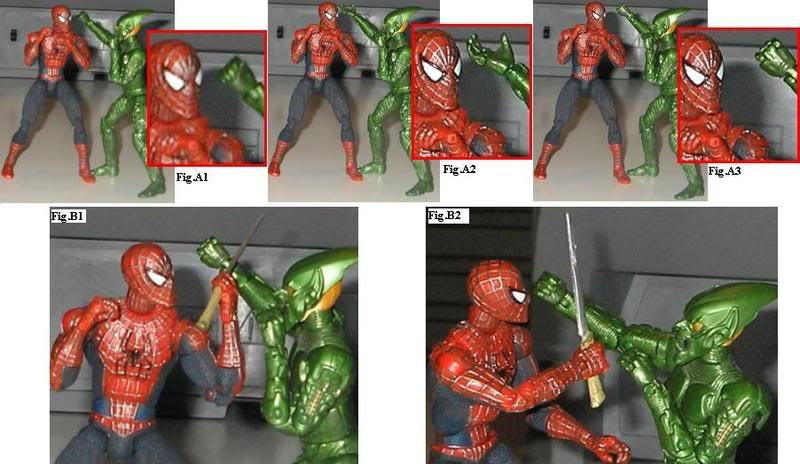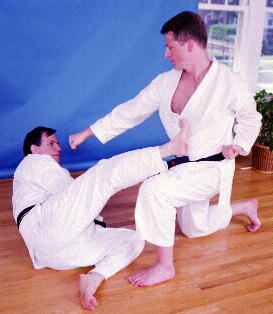Here's the old thread
There are two things I want to start discuss here:
1. Roundhouse punches: dos and don'ts
2. Ducking and weaving: why bother?
Roundhouse Punches
Believe it or not, but some people don't know how to throw a real roundhouse punch - and I think this comes from the fact that some people are too used to training with boxing gloves on or that they train for competitions rather than self defence... I don't know... I've only seen a few schools teach this dubious style of roundhouse punching (thankfully most schools I've seen don't teach this way).
Anyway, here's what I'm talking about...
Fig.A1: This is the dubious roundhouse punch in question here. I've heard some people describe it as "holding a coffee mug" - so you imagine you're holding a coffee mug while swinging your fist around to the opponent. In other words, your palm is facing toward the opponent. I have two problems with this method of punching.
1/ it doesn't deliver as much torque (and thus generate as much power) as more conventional forms of roundhouse punching (Fig.A3) due to the lack of rotation in the forearm. Remember that torsion is rotational energy - the more you twist the more torque you generate. So bio-mechanically speaking this is a weaker punch.
2/ It leaves exposes the softer part of the forearm and wrist (re: tendons!) toward the attacker, which leaves it vulnerable to attacks, particular to being cut by a blade (more on this in a moment).
Fig.A2: Not a roundhouse punch, but a "Karate chop" which is a similar style attack only that it's an open hand instead of a fist. I think it's also called a knife hand or "shuto" in some styles. Although not a punch I prefer this over the "coffee mug" style as it at least gives you a 90 degree forearm/wrist rotation, thus generating more torque. The palm is facing "Heaven" (upward) and the softer part of the forearm and tendons are not directly facing the opponent.
Fig.A3: What I consider to be a more conventional roundhouse punch and it's what I've seen more commonly done in martial arts - Kung Fu, Karate etc etc.
1/ This gives you a 180 degree rotation, double the amount of torque generated by the 'chop.' This kind of roundhouse punching was favoured by Muslim warriors during the Crusades.
2/ The palm and tendons are facing away from the opponent, leaving the harder part of the forearm/wrist facing the opponent.
Now, in the chance that your roundhouse punch is intercepted by a blade and you get cut, here are the options offered by the "coffee mug" and more conventional styles of roundhouse punching.
Fig.B1: In the conventional style, the blade cuts the harder side of the forearm/wrist (this part of the arm can be hardened through conditioning) - although it's painful and unpleasant, with most superficial slashes you will be able to continue using that forearm and hand in fighting.
Fig.B2: In the "coffee mug" style, the blade cuts the softer side of the forearm/wrist and it doesn't take a deep slash to cut the tendons. Once the tendons are cut, your hand is rendered ineffectual - not to mention that it's a whole lot more painful too. This part of your forearm cannot be hardened through conditioning. Even the toughest body-building gym junkie will have soft wrists around the tendons. That's why it's easy to feel someone's pulse around there.
So yeah... my conclusion about the coffee mug style is that it's just a big waste of time. :/
Ducking and Weaving
Ducking and weaving is a technique commonly used in competitive fighting sports like modern boxing. This is all fine in a sport environment where you're essentially just fighting as a game, but it's a whole different matter when you're looking at self-defence. The reason why I'm bringing this up is because I have come across a few schools that actually teach their students ducking and weaving but without disclaiming that the move cannot be used in a real fight, and in some cases, claiming that it can be used in self defence.
Here's a simple description of how ducking and weaving works and why I have my doubts about its application in self defence...
Fig.A: The attacker (Green Goblin) throws a roundhouse punch at the defender's (Spiderman) head.
Fig.B: The defender ducks under the attacker's incoming punch and will weave out to the side for a counterstrike.
Fig.C1: Defender has weaved and stepped out to the side and launched a punch back at the defender.
That's ideally how ducking and weaving is supposed to work. My question about this move is that when the defender is ducking and weaving under the incoming punching arm, he leaves his neck and upper spine exposed, allowing the attacker to quite easily attack the neck/spine (Fig.C2). In this example I've got the Green Goblin dropping his elbow onto Spidey's vertebrae, but he could also deliver a downward chop, punch etc. - all kinds of nasties... the problem here is that Spidey has left his spine totally exposed.
In competitive sports like boxing, it is illegal to attack the spine, hence they don't defend it. In a real fight, there are no rules.








 Reply With Quote
Reply With Quote







 It's for this same reason that I've often been critical against people who expose their genitals in a fight. Works fine in the ring where attacking the genitals is disallowed, but not in a real fight.
It's for this same reason that I've often been critical against people who expose their genitals in a fight. Works fine in the ring where attacking the genitals is disallowed, but not in a real fight. 




